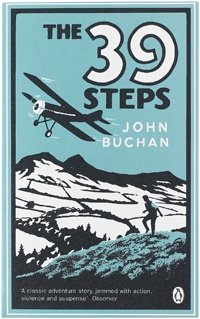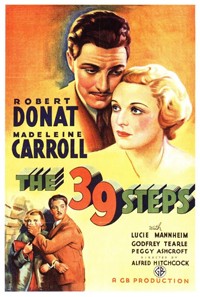First published in 1915, it’s hard to believe that The Thirty-Nine Steps is nearly 100 years old. It has formed the basis for a number of film adaptations – usually with the title shortened to The 39 Steps – including the British thriller directed by Alfred Hitchcock in 1935, which itself is considered a classic. There was a colour remake directed by Ralph Thomas in 1959, and a third version directed by Don Sharp in 1978. In 2008 the book was adapted for television in the UK, and this version seems closest to Buchan’s original text. And, of course, there is a stage adaptation which is currently being performed at the London Criterion Theatre. Given its popularity, The Thirty-Nine Steps is something we had to include in Classics in September.
The book is set in 1914. Richard Hannay, the narrator of the story, returns to London after a long stay in Rhodesia. One evening whilst on his way home from a night out he is approached by a stranger as he opens his front door. In the gloom of the night, it takes a moment to recognise the man. It’s Mr Scudder, his neighbour from the apartment upstairs. Scudder claims to need help and explains he is in fear for his life. Hannay lets Scudder into his apartment where the man begins to tell a long and unlikely story of espionage across Europe, detailing the assassination of the Greek Premier Karolides during his visit to London. Scudder claims that he has faked his own death in order to avert suspicion.
During his story it is revealed that the man is actually Captain Theophilus Digby of the 40th Gurkhas and he has been following a ring of German spies known as the Black Stone. The next day the body of a man is discovered having apparently committed suicide, which serves to re-enforce the elaborate story. Hearing this, Hannay decides to hide Scudder in his apartment.
Scudder stays for four days until one evening after returning from dinner he is found sprawled on his back, with a long knife through his heart, skewering him to the floor. Fearing he will be next, and that the police will never believe him, Hannay flees with a plan to stay in hiding for the next three weeks. He intends to pick up where Scudder left off. So, Hannay bribes a milkman into lending him his uniform in order to escape unnoticed and, carrying Scudder’s black book, he catches a train from London St Pancras to Scotland.
The next days and weeks are spent on the run – from both Scotland Yard and the German spies. He seeks help and refuge from an innkeeper, a local landowner, a road mender and a politician along the way. Whilst on the run Hannay must work out the cypher for Scudder’s notes in order to save Britain.
The Thirty-Nine Steps is an exciting story of adventure, murder and espionage. Although written in 1915 the book does not feel dated – it’s still very enjoyable nearly 100 years on. John Buchan’s great descriptions of the Scottish Highlands might be what draws you into the story so that you feel as if you’re becoming a part of it. The novel is fast moving and exciting and never leaves you bored. The plot is obviously a little far-fetched, with one man managing to out-wit and escape a group of German spies and the best brains of Scotland Yard. If it had been written today, the frequent co-incidences in the storyline would be reason for criticism, but perhaps they are part of the book’s charm. In 1915, with all the bloodshed across Europe thanks to World War I, weren’t readers deserving of a little escapism?
What makes The Thirty-Nine Steps a classic is that almost a century later it is still being read and enjoyed. Compared to modern day crime fiction there are fewer detailed descriptions of the crimes, deaths and mystery angles. The antagonists in this novel are also very different to the ones you find in modern day crime fiction. They are spies who are following orders, rather than evil killers. There is little or no psychological analysis of the protagonists. The focus is more on the adventure Hannay is thrust into – an adventure that he enjoys immensely.
The Thirty-Nine Steps is the archetypal ‘man on the run’ book, and countless novelists and script writers have used that theme as the basis for their plots.
The Collector’s Library has published a nice hardcover version of the book, or you can enjoy it free on your Kindle from Amazon (see the links below). Better still, look for an old copy in a secondhand bookshop. The book has been published with numerous wonderfully illustrated covers over the years.
Collector’s Library/various
Print/Kindle/iBook
£7.29
CFL Rating: 5 Stars












